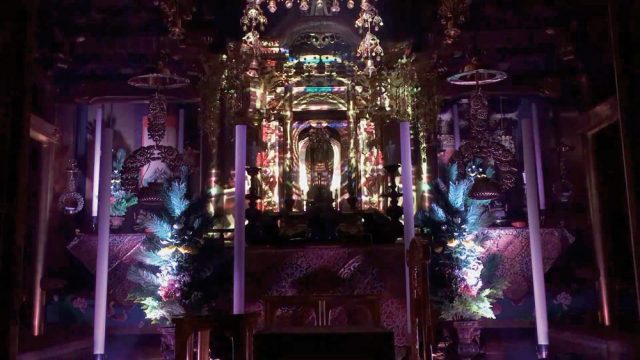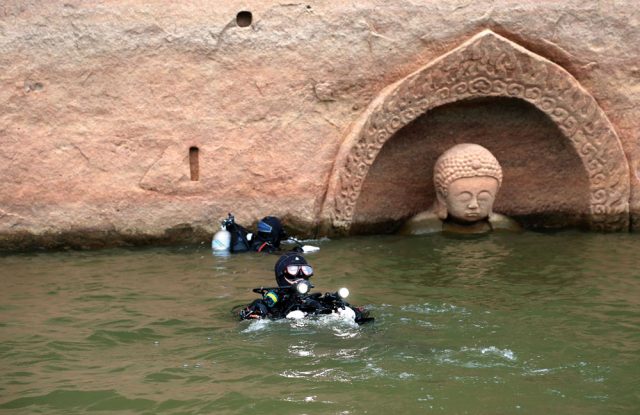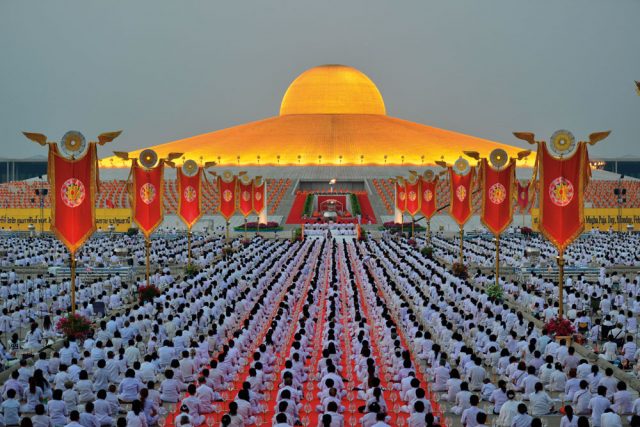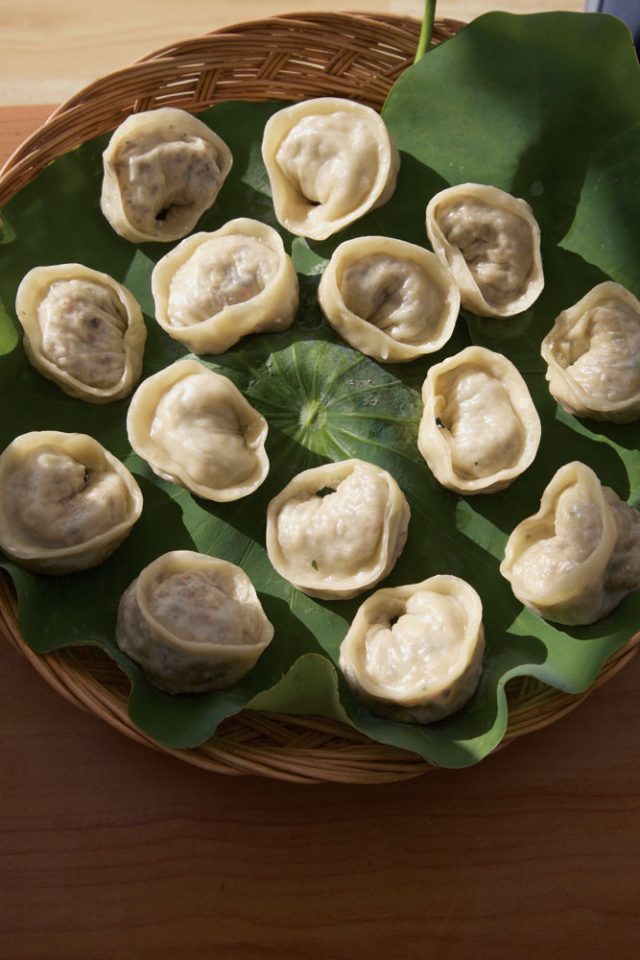
Techno Temple
Amitabha Buddha’s Pure Land, a heaven-like celestial realm, is described in the sutras as a land of immeasurable light. Throughout history, temples have used the most advanced technologies available to them—such as gold leaf and candles—to recreate this otherworldly illumination in ritual practice. Now one Japanese Buddhist priest wants to present a 21st-century version of what the Pure Land looks like. Which is, apparently, a lot like a warehouse rave. Gyosen Asakura, a 49-year-old former DJ and the current priest of Sho-onji, a Pure Land Temple in Fukui City, Japan, started leading memorial services last year that feature psychedelic lights, original breakbeat compositions, Buddhist chants, and computer-generated imagery. He has run two such services so far under the name “Show-On-G Memorial Service,” in a playful take on the temple’s name, and is raising money for a third. In an interview with Japankyo.com, a site specializing in oddball stories about Japanese society and pop culture, Asakura explained that he was inspired by the Pure Land sutras to find a new way to worship: “What I want to do with this project is use lighting and contemporary technology . . . to make it possible for people to get a more accurate image of what Lord Buddha’s world looks like.” He hopes his efforts will draw a younger (and, dare we say, hipper) crowd to his temple and to the Buddhist faith. Experience the temple’s light show for yourself here.

A Buddhist Atlantis
The lost island of Atlantis may have been an allegory, but in China some real-life ruins have just emerged from their own watery depths.
This winter, a 600-year-old Buddha head was discovered peeping out from a reservoir in Jiangxi Province. The 12-foot-high statue, carved into a cliff face, was spotted by a local villager when the water level dropped during work on a hydropower gate. Water had swallowed up the statue during the reservoir’s construction over 50 years ago. (Villagers alive at the time of the reservoir’s construction remember it as gilded.) Perhaps because of its submersion, it has remained relatively untouched by weathering and oxidation. Moreover, its time underwater spared it the fate of so many other cultural relics destroyed during China’s Cultural Revolution in the 1950s and ’60s. In fact, it turns out that the statue may be just the beginning of the treasures the reservoir is hiding. An underwater archaeology team investigating the site has already found the base of a temple hall; records suggest that the reservoir covers the ruins of an ancient town.
Buddha Come Home!
In 2012, a 20-inch bronze Buddha statue was stolen from an island off Nagasaki, Japan, by South Korean thieves who argued that they were returning the artifact to its rightful home: a document found inside the statue showed that it had been dedicated to a temple in South Korea in 1330. The South Korean government had been prepared to return the statue until its court ruled in favor of the thieves this winter, deepening a rift between the two nations that dates back to Japan’s colonization of the country before WWII. Japanese pirates may have plundered the statue in the late 1300s—they often raided sites in Korea at that time—but the statue may also have been legally acquired. There’s evidence that at one point it found its way to Tsushima, a Japanese island in the Korea Strait where much lawful trade has taken place over the centuries. For now, the legal fate of this spiritual relic rests in a bardo state.

Buddhist Bad Boys
Even the very best of Buddhists sometimes break the precepts. But this year, two Buddhist monks may have brought monastic disobedience to a new level.
Thailand’s ruling military junta is currently on the lookout for Phra Dhammachayo, the former abbot of the country’s biggest and richest monastery, Dhammakaya Temple. He has been accused of money laundering, encroaching on public land in southern Thailand, and building meditation centers on illegally acquired and cleared property. Earlier this year, police ordered all nonresidents of Wat Phra Dhammakaya to evacuate for a search, which was no small undertaking: the temple housed nearly 13,000 people, although the monks were allowed to stay inside.
Phra Dhammachayo is said to have had links with the former premier Thaksin Shinawatra, a populist leader overthrown in 2006, and many feel that the warrant for the abbot’s arrest is politically motivated: the temple has been one of few institutions to defy the military junta, which has controlled the country since a 2014 coup that ousted the former prime minister Yingluck Shinawatra, who also happens to be Thaksin’s sister. Meanwhile, to the north, in Burma, another Buddhist bad boy, a monk named Arsara, was apprehended by police as he transported hundreds of thousands of methamphetamine pills in his car. When officials searched the monk’s monastery, they discovered an additional 4 million pills. The renegade monk had been driving from Shwe Baho village in the Rakhine state, which is home to more than a million people from the Muslim Rohingya minority and an area of the country deeply affected by the illegal drug trade. Meth pills are popular across Asia, and Burma is a major producer of these, along with other illegal drugs including opium and cannabis.

Michelin Monastic
Jeong Kwan is a 60-year-old Zen Buddhist nun who lives at Baekyangsa Temple in South Korea, three hours south of Seoul. She has lived as a monastic for approximately 40 years, which is to say that she’s not the likeliest of subjects to be featured on a Netflix original series. However, Jeong also happens to be a world-class cook, and the first episode of Season 3 of Chef’s Table, a documentary series that profiles internationally recognized chefs, focuses on the masterful all-vegan meals she prepares for her fellow monastics.
Jeong Kwan’s philosophy of food and cooking is deeply impacted by her faith. She avoids meat and dairy entirely, along with garlic, onions, scallions, chives, and leeks, the “five pungent roots” that monastics are traditionally banned from eating due to their potential to agitate the mind and body. One might think this would leave a chef with nothing but bland vegetables and a variety of noodles to work with, but when Eric Ripert, chef and co-owner of the New York City restaurant Le Bernardin and a Buddhist practitioner himself, visited Jeong Kwan’s monastery while traveling through Korea, he found that her cooking was in the same league as a Michelin-rated restaurant in New York City or San Francisco.
In the episode, Jeong Kwan reflects on food as meditation and prayer, discussing how her careful meal preparation is an expression of gratitude to her deceased parents.
Thank you for subscribing to Tricycle! As a nonprofit, we depend on readers like you to keep Buddhist teachings and practices widely available.